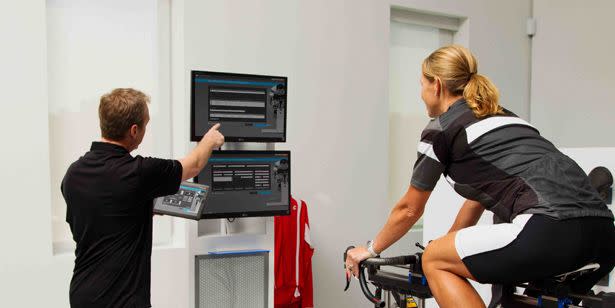3 Keys to a Better Bike Fit

Whether you are buying a new bike, switching between bikes, or simply installing a new saddle, bike fit is important. It’s not just about setting your seat height, however. To keep your road bike position the same, every time, every ride, there are three measurements that you should be aware of—and checking constantly.
Saddle Height
Saddle height is arguably the most important measurement for cyclists. It’s key because it impacts your comfort level, your ability to crank out watts, and your knee health. It’s also the one that is the easiest to set, but also the easiest to shift or slip. Whether you’re removing the seatpost for travel or just setting up a bike to demo at a shop, knowing your measurement is key.
“You see so many commuter bikes with too-low seats,” says Tara Lazarski, a physiotherapist who works with pro cyclists from her office at Catalyst Kinetics Group in North Vancouver, and on the road with the Canadian national mountain bike team. “I think it’s a style thing, but it’s so bad for you!”
To get the proper seat height, you want the saddle to be high enough that your heel barely touches the pedal at the bottom of thepedal rotation, but not so high that your heel comes above your toes at the bottom of the pedal stroke. Once you’ve found the sweet spot, measure the distance from the top of the saddle to the center of the pedal axle, with the pedal positioned furthest away from the saddle. Record that number and keep it somewhere handy for easy reference.
RELATED: Wisdom from the Most Controversial Man in Bike Fitting
Saddle Setback
“Improper saddle position can lead to serious issues,” Lazarski says. If your saddle position isn’t dialed, you run the risk of numbness in your nether regions, while also being at a higher risk for injury and discomfort. A proper saddle setback (adjusted by moving your saddle forward or backward) can alleviate pressure on the wrong parts of your pelvis while increasing your power.
That makes saddle setback another important measurement to get right, and it’s an easy adjustment to make. If you loosen the bolts attaching the saddle to your seatpost, you’ll be able to move it forward and backward to find the sweet spot. The front of your kneecap should be directly over your pedal spindle when you’re mid-pedal stroke. Most bike fitters dangle a piece of string with a small weight at the bottom (a plumb line) from the side of the rider’s kneecap to see if it lines up directly with the spindle—you may need to enlist a friend to help get this exactly right! Note where your saddle is slotted into your septets: many saddles actually have rulers marked on the rails, so it’s an easy measurement to note.
Reach to Your Handlebars
Handlebar reach is simply the distance you reach from your saddle to your handlebars. A too-long reach (when you’re stretching really far to reach the bars) can mess with your weight distribution across the front and back wheels of your bike, meaning that you risk being uncomfortable and having trouble controlling your bike. A too-short reach (where you’re sitting more upright because the distance is so short), on the other hand, can be just as bad, making your position too upright, decreasing your power and making your control twitchy.
“The length of your stem and the length of the top of your bike are important when it comes to buying a bike,” Lazarski says. You can make minor adjustments by swapping your stem, but this is one measurement to know before buying a bike.
“Make sure that the front-to-back dimension of a bike is right for you,” she says. “The stem shouldn’t need to be super short or super long to make the bike fit you.” Ideally, you should look for a reach where your elbows bend slightly when your hands are on the hoods—without your spine flexing and bending to reach the bars—for a good road bike fit. The way to measure and record reach is from your seatpost, right under the saddle, to your headset, and if you already have a great-fitting bike, noting its top tube length for future bike shopping.
RELATED: 7 Easy Bike Fit Fixes
If you’re still struggling to nail these three measurements, you may want to consider a professional bike fit as a good investment for your cycling career. A bike fit helps you avoid issues like chronic knee or back pain, according to Lazarski, and for most riders, a proper fit will also feel more comfortable and help them pedal more efficiently.
And before you leave your bike fit session, ask the fitter to write down these key measurements for you!
You Might Also Like
